An audiophile perspective on headphones from a vacuum company.
- Balanced neutral sound – especially for ANC headphones
- Effective and light-handed noise cancellation
- Extremely well made
- Great accessories
- Good app
- Filter urban air pollution
- 50-hour battery life in audio mode
- Visor easily removable with magnetic attachment
- Divisive looks garner lots of attention
- Expensive
- Larger and heavier than typical ANC headphones
- Fans are audible
- Battery life in fan mode is limited
Where to Buy
Introduction
Why is it that the 2023 headphone release that’s receiving the most interest is not from an audio company?
Originally announced a few days before April first, 2022, the Dyson Zone headphones seemed perfectly poised to be the quintessential April Fool’s Day joke. Looking like a blingy Batman villain Bane costume piece, discount store Ant-Man, or Daft Punk tribute, the Zone feature a headphone-industry-first face shield air purifier system.
I’m going to address the cosplaying elephant in the room in an effort to move on.
Timing the announcement and release of the Zone with a global pandemic means most folks may immediately assume these are a high-tech alternative to an N95 mask. They are not. The face shield does not touch the wearer’s face to create a seal. So, let’s put that assumption to bed.
The Zone do not provide COVID protection, nor are they meant to.

With the visor in place, the Zone are intended to filter urban air pollutants for the wearer. They have replaceable filters and miniature fans that suck in air through the exterior ear cup grills and blow the filtered air to the wearer’s face through channels in the shield.
The mask part is lightweight (albeit somewhat flimsy feeling), constructed from plastic and rubber, and pops on and off the headphones via magnets on both sides.
The visor can also be pulled down to speak to others, and pivots on the magnets to hang under the chin. This position turns off the fans, puts the headphones in transparency mode, and pauses playback.
So, let’s put all that face shield, air-purification stuff behind us for this review. Today, we’re going to focus on the other side of the Dyson Zone equation, hidden behind the showy visor. In a market where more and more consumer ANC headphones are appearing around USD-$1k, has a vacuum company managed to outdo the traditional audio companies?
In many surprising ways, the answer is yes.
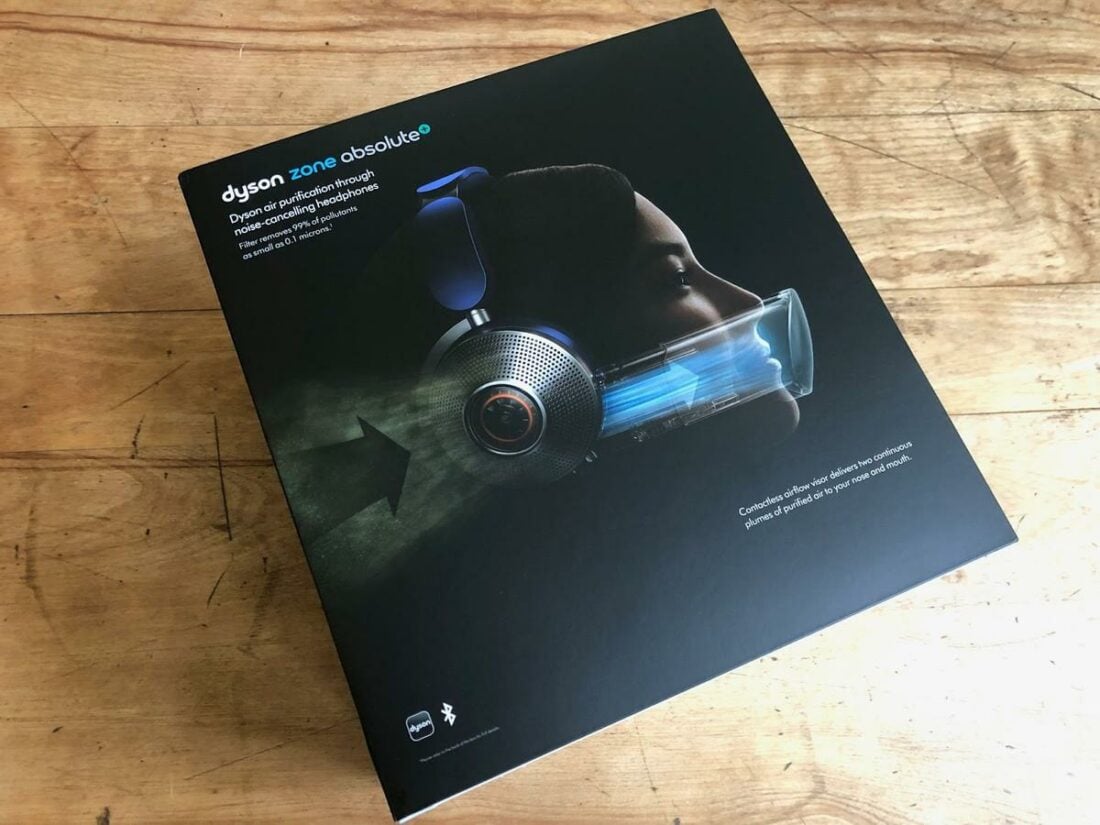
Packaging
The Zone arrive in a typical consumer product cardboard box wrapped in a colorful paper sleeve. Lots of attractive pictures, specifications, and marketing claims. Nothing particularly new here, although the styrofoam-free recyclable paper packaging is appreciated.
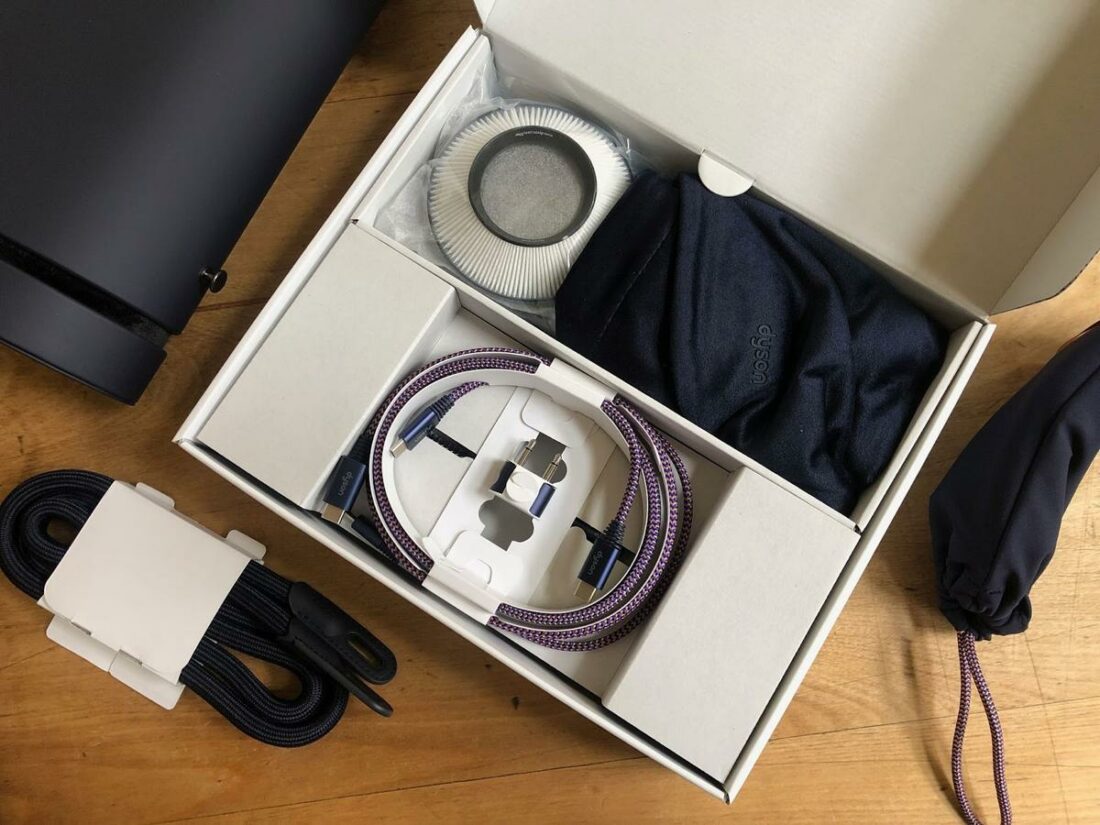
In the box
- Dyson Zone headphones (‘Base’ model: Ultra Blue/Prussian Blue; ‘Absolute+’ model: Prussian Blue/Bright Copper – as tested)
- Magnetic face visor
- Electrostatic carbon filters (2 sets with the Absolute+ model)
- Visor cleaning brush
- USB-C charging cable
- In-flight adapter, USB-c to 3.5mm cable (with the Absolute+ model)
- Premium hard case (with the Absolute+ model)
- Velvet storage pouch (with the Absolute+ model)
Last year, I was disappointed with the accessories included with the premium Focal Bathys ANC headphones. Cheap black plastic cables seemed far below the brand’s reputation and product status.
Conversely, my jaw fairly dropped when I unboxed the Zone.
Audio companies take note – this is how you do high-quality accessories.
The technical stuff like filters and brush are, unsurprisingly, Dyson’s bread and butter, and fit perfectly and seem very well constructed.
The velvet storage bag is surprisingly plush and luxurious. The hard case reminds me of high-end binocular storage and sports a thick, supple cord for shoulder transport.
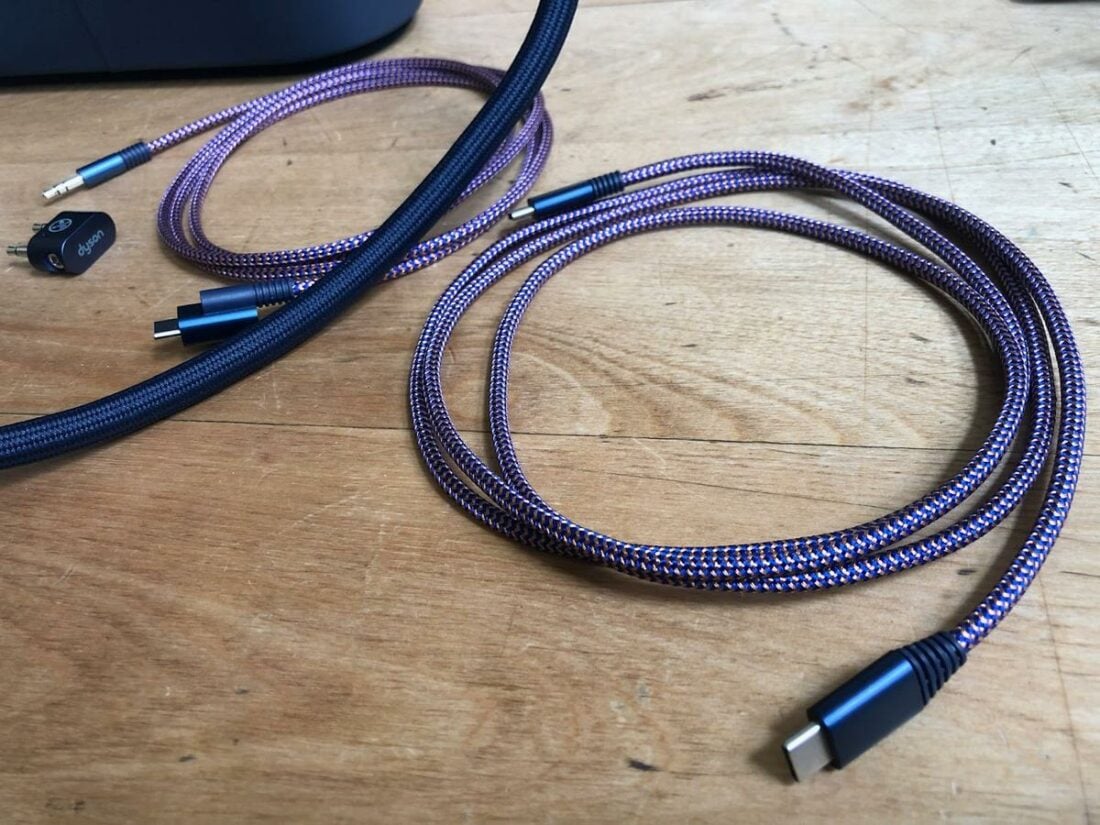
The cables? Wrapped in braided, color-matched fabric, they terminate in sturdy aluminum plugs. If you’ve ever splurged for higher-end charging cables from brands like Anker, you’ll understand the value of superior construction. Wow.
Battery ⓘ
- Battery Life: 50 hours (audio only)
- Charge Time: 60% battery in 20 minutes
Used simply as headphones without the mask, battery life is up to an impressive 50 hours depending on volume, codec, ANC, etc. Use of the filtration mask lowers this significantly to a mere 4 hours on the lowest fan setting (which Dyson calls ‘rest’), 2.5 on medium (‘light’), and 1.5 on max (‘moderate’).
It takes about 3 hours to fully charge the 2600mAh battery, although they can be charged to 60% in only 20 minutes.
UX ⓘ
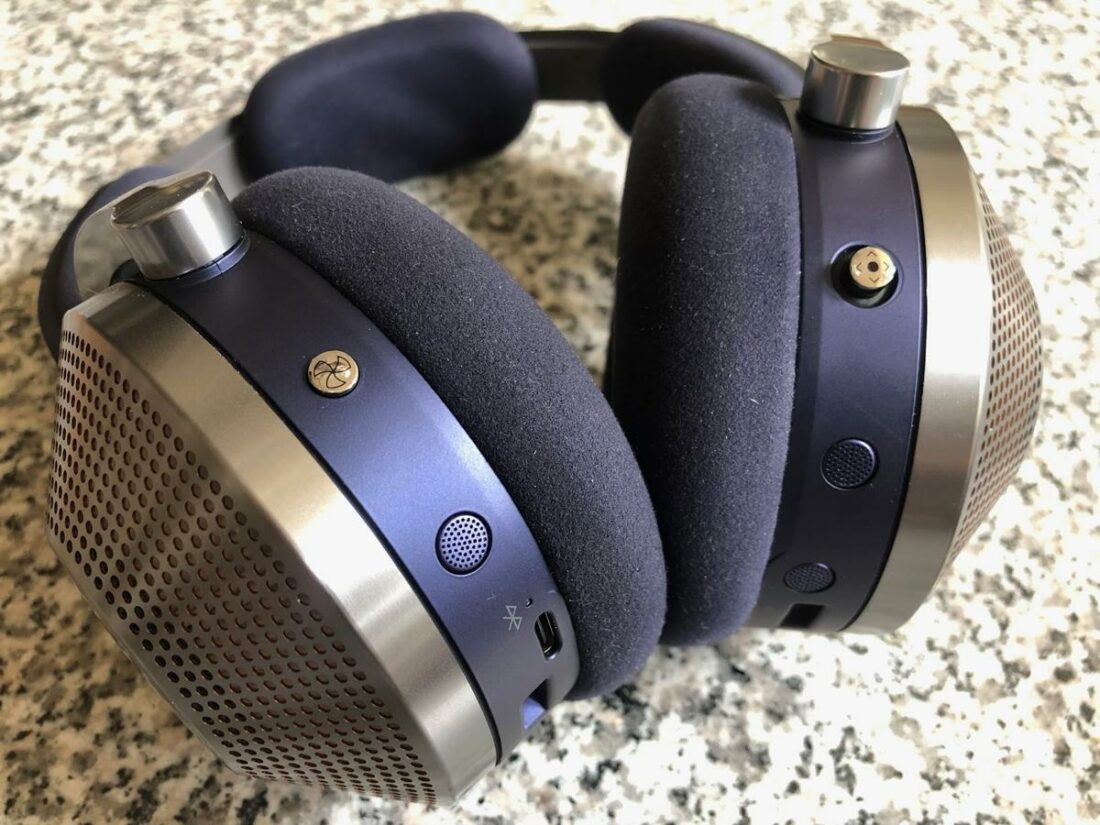
- Control Mechanism: Touch surface on the outside of the cups and a joystick on the right cup
- Touch Accuracy: Outstanding
- Control Symmetry on both ear-cups: Yes
The control design is both unique and intuitive. Double-tapping the outside of a cup toggles between ANC and transparency modes. A fairly large (6mm wide) button adorned with a fan icon is located on the back of the left cup. Additionally, a small but sturdy joystick protrudes a few millimeters out of the back of the right cup.
Pressing the fan button, unsurprisingly, cycles through the three fan speeds (plus auto and off) when the visor is in place. Holding this button also triggers Bluetooth pairing and power on/off.
The multi-function joystick is a pleasure to use. Click to play/pause. Hold in for Siri or Google Assistant. Tap left/right to skip, and hold to fast forward/rewind. Up/down for volume. I expected the audio control and functionality to play second fiddle to the filtration on a Dyson product, but it seems they spent a lot of time perfecting the details.
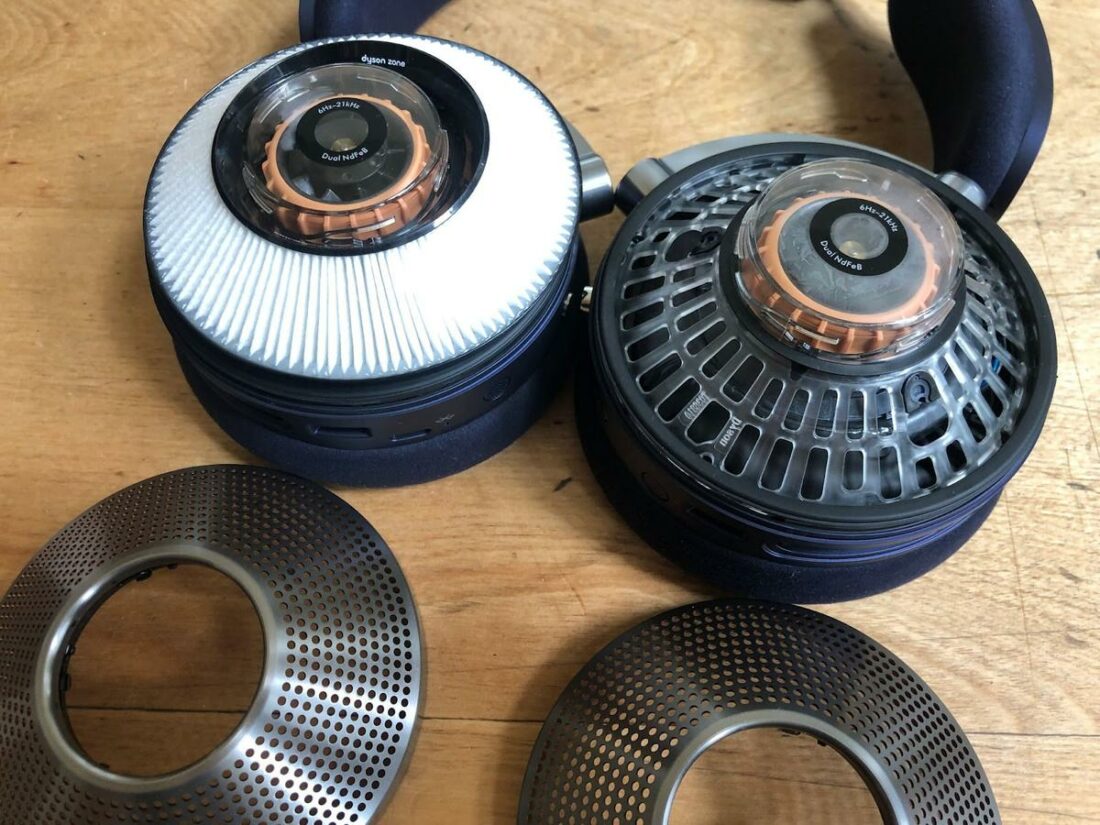
Design ⓘ
- Profile: Over-ear
- Material: Aluminum, steel, plastic
- Fit and Comfort: Outstanding
The Zone are big and heavy for a pair of ANC headphones.
There, I said it. But I caution you, headphone enthusiasts, not to make too much of this.
Really, the chonkiness should come as no surprise since the average pair of ANC headphones do not have tiny motors, filters, fan assemblies in each ear cup, or a detachable face mask. The Zone weigh in at a bit less than 600g without the mask and about 675g with it attached.
Those with audiophile tendencies may have encountered the average pair of Audeze LCD headphones, which start around 600g and are significantly larger than the Zone cups. The Hedd HEDDphone are the chunkiest headphones I’ve ever worn at over 730g and are much more massive on the head than the Zone.
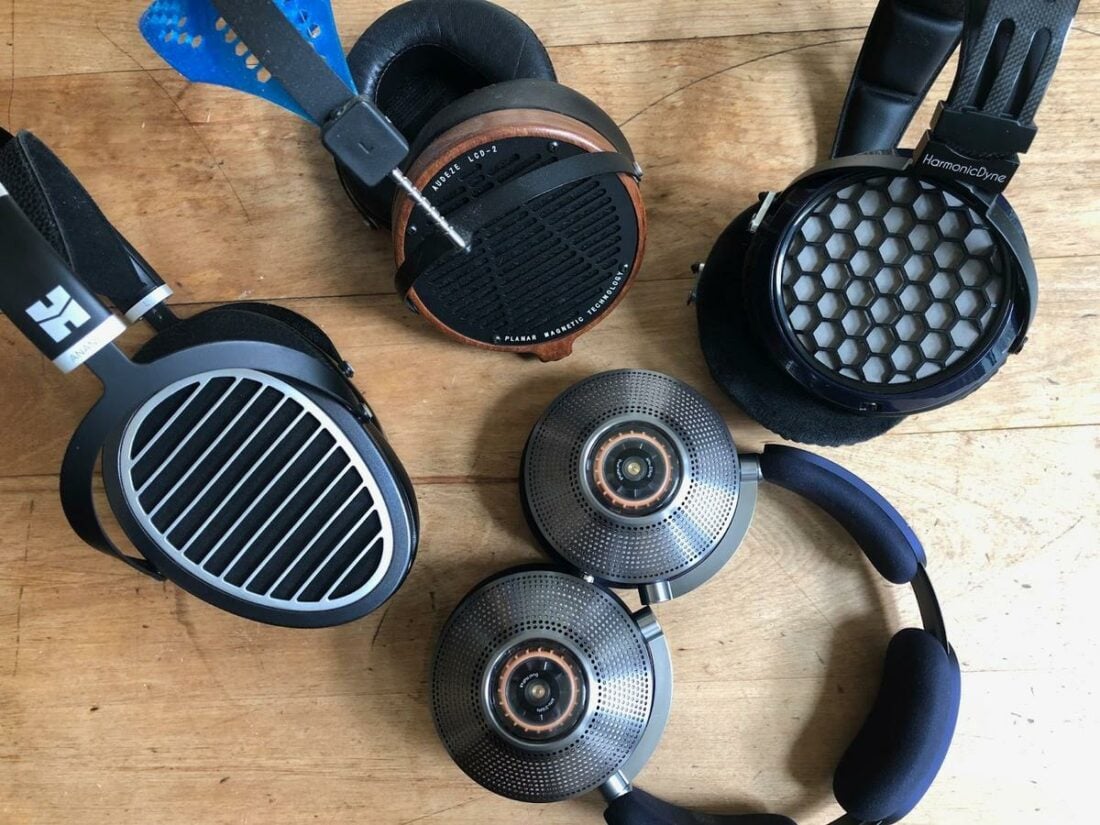
The Zone pull off multi-hour listening comfort and moving about better than the audiophile behemoths despite their weight.
Another aspect that the Zone share with these high-end audiophile headphones is their outstanding build quality. Typical lightweight ANC headphones are that way due to their flimsy feeling, all-plastic construction. Not so with the Zone.
Dyson could have saved a few hundred grams and sacrificed luxury and robustness, but instead, they built an impressive pair of headphones.
The single-sided yoke connecting the band to the cup is a curved 8mm square solid aluminum rod. I’ve not encountered another headphone with this substantial design.
The band, which Dyson reports was inspired by “the shape and design of a horse’s saddle,” distributes the weight remarkably well for a non-comfort strap configuration. Clamp force is significant but not uncomfortable due to the well-padded velour ear pads.
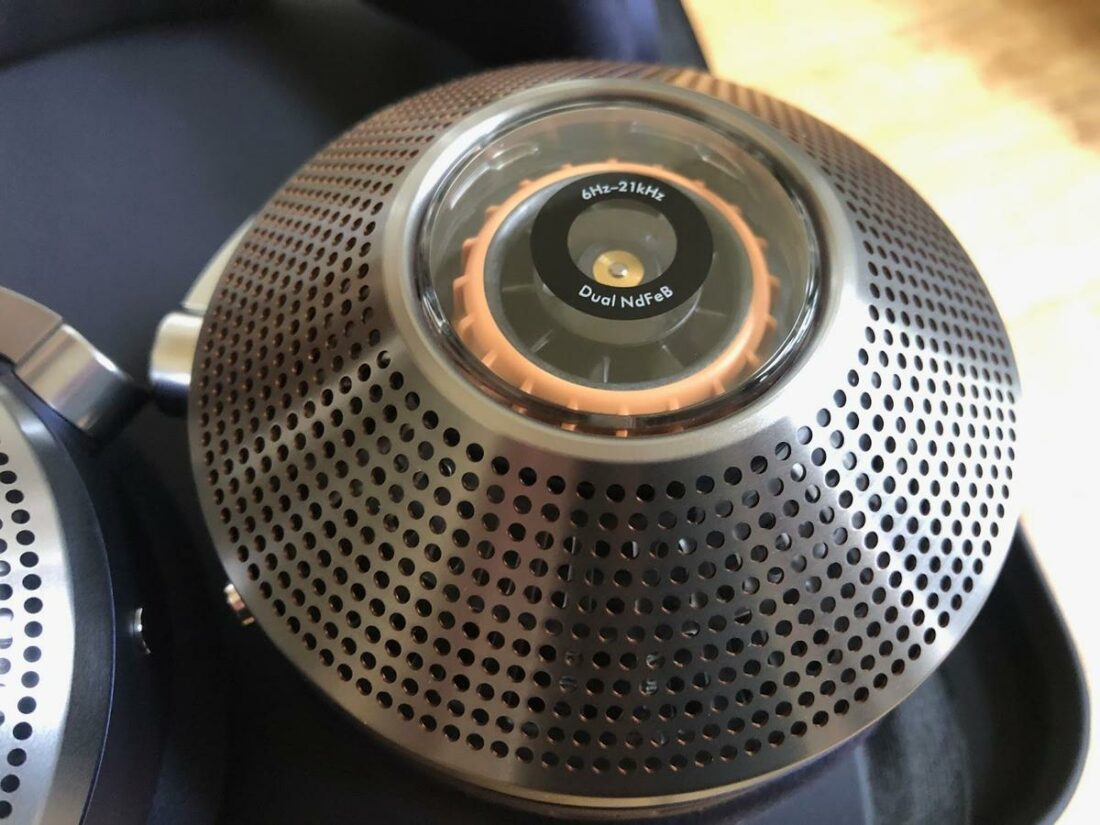
Cup interiors are plastic, while the removable perforated grills are metal. A neat design choice is the clear center windows in the cups, sporting “6Hz-21kHz, Dual NdFeB” for the headphone spec nerds, yielding a view of the fan and motor within.
The only flimsy-feeling component is the plastic and rubber face visor – understandable, as weight savings are paramount for this part. I’ll point you toward the leverage chapter in your old high-school physics book. Wearing the visor requires rotating the Zone’s headband fairly far back on the head, near my usual position, but some might find this a bit odd.
Mic ⓘ
- Noise Cancellation: Good
- Voice Pick-up: Average
Microphone clarity is excellent in a quiet environment and merely average with 70dB+ of background noise, although the environmental noise is effectively muted.
Mic demo
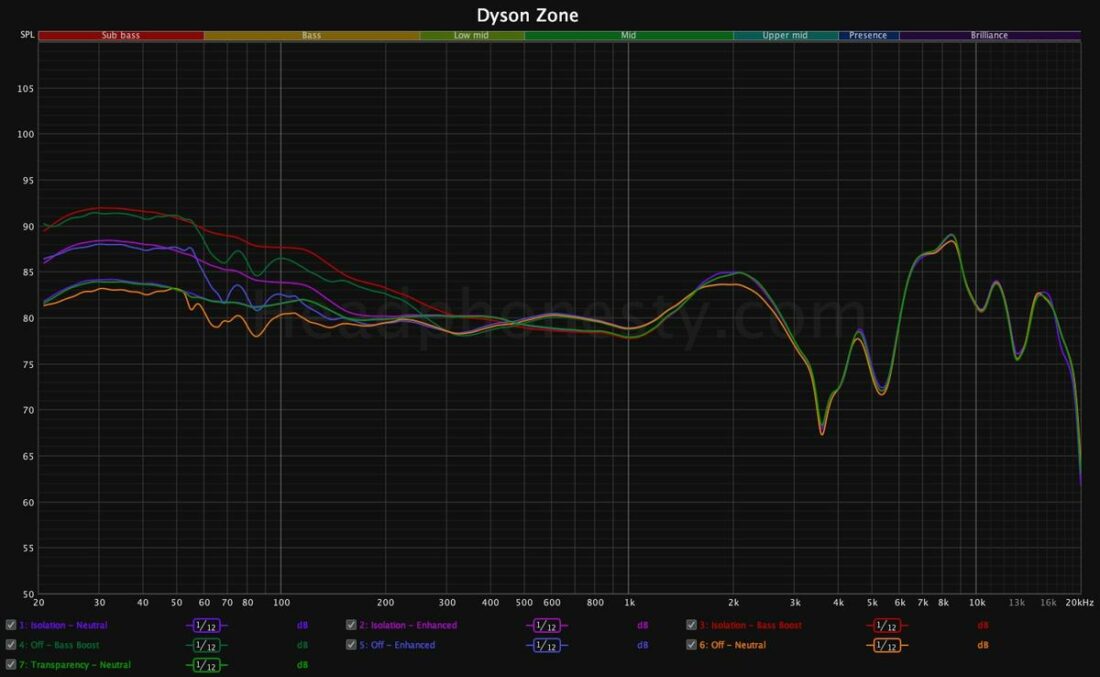
Sound ⓘ
- Driver: 40mm, 16-ohm neodymium magnet
- Sound Signature: Balanced with boosted treble
- Bass: Good
- Mids: Average
- Treble: Good
- Soundstage: Good
- Imaging: Average
- Dynamics: Good
The Dyson Zone are surprisingly neutrally tuned for ANC headphones, especially in the aptly-named ‘Neutral’ EQ setting. Compared to industry leaders such as the Momentum 4 or 1000XM5, the bass is far more even-handed (less boosted), while the higher frequencies above 6kHz are more extended.
The Zone’s tuning far more closely resembles the much-lauded Focal Bathys than the others. Although, the Zone have less sub-bass roll-off and a flatter mid-bass than the Bathys, with a similar high-end.
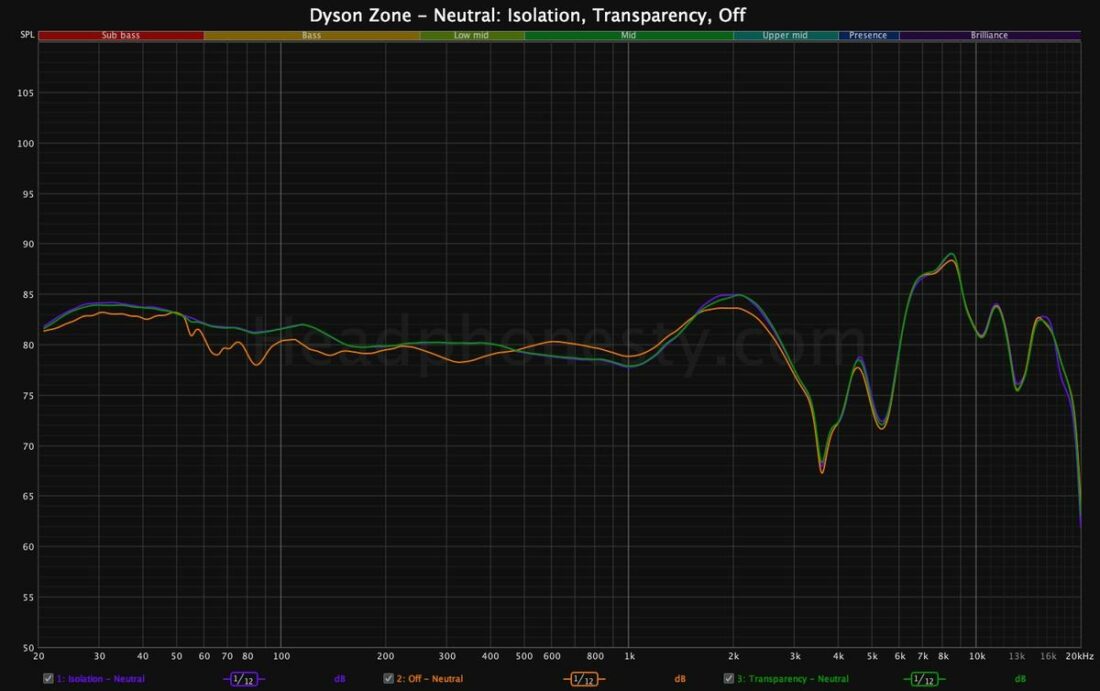
An interesting thing happens when the Zone’s ANC is turned off (something the Bathys can not do, BTW). The FR response doesn’t radically change, it mainly develops some subtle unevenness in the lower bass. It looks like these headphones rely on a good driver and design more than ANC DSP trickery for their sound, which is something I appreciate.
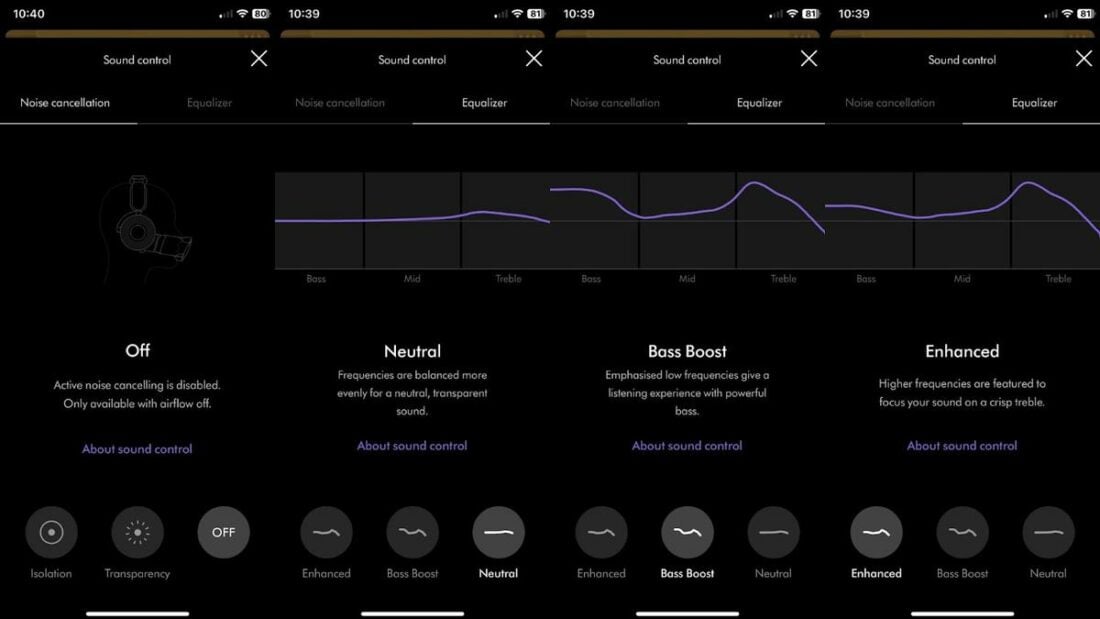
The effect of the 3 EQ settings isn’t how the Dyson app portrays them. The ‘Bass Boost’ setting is as advertised, with a steady rise under 500Hz, with about an 8-9dB gain over ‘Neutral’ in these lower frequencies.
The ‘Enhanced’ setting appears in the app like it should boost the higher frequencies, but, in fact, it is merely a lesser bass boost (5-6dB), leaving the midrange and treble virtually unchanged from ‘Neutral.’
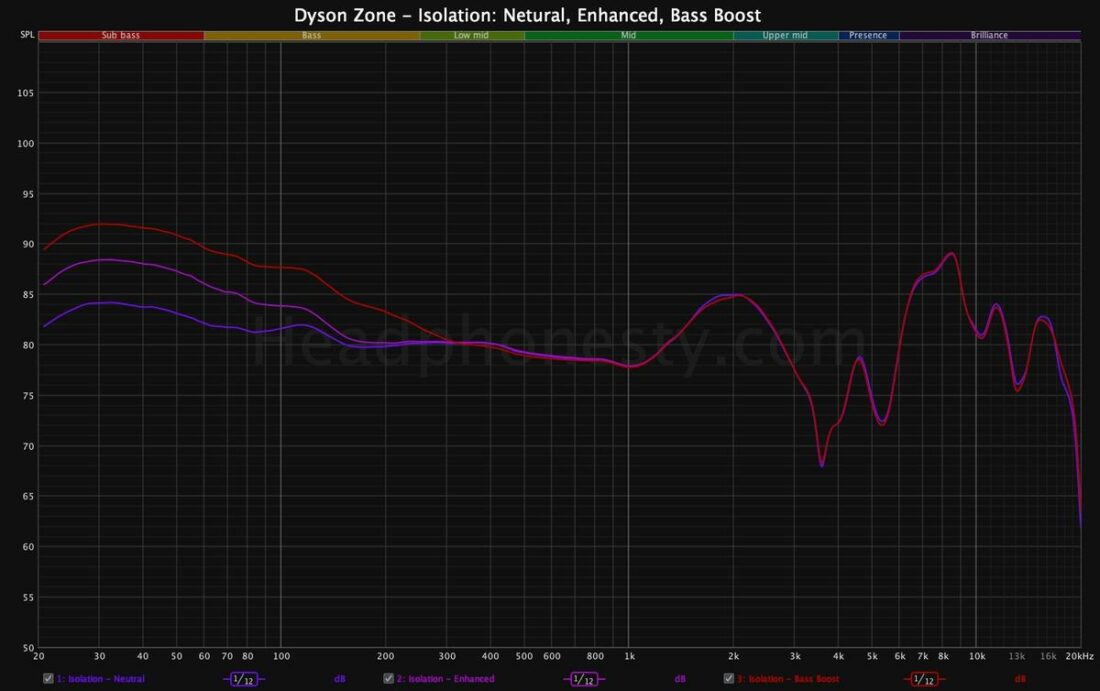
Bass
Using the ‘Neutral’ EQ mode, the focus is more on the higher frequencies and registers, although there is enough low-end presence to imbue the music with sufficient warmth and weight. Balance and neutrality are not something I often encounter with ANC cans, but the Dyson are refreshingly tuned.
The low frequencies descend remarkably linearly, with no major shelves or roll-off, and instruments sound full and real. Boosting the bass via EQ certainly adds presence, and the Dyson manage to pound without becoming too muddy or congested.
Mids
The midrange takes a step back from the other frequency ranges but maintains adequate energy to ensure that voices sound natural. I wouldn’t go so far as to describe the midrange tonality as rich or exciting, but there isn’t much lacking. The upper-midrange rise around 2Kz manages to avoid shoutiness or sounding nasal.
Treble
There is great energy to be found 6kHz and upwards. This gives a feeling of detail and clarity while avoiding strident edginess. For this type of headphone, the Zone sound remarkably spacious and airy. This helps provide the impression of a larger-than-normal sound stage – more extensive than the typical in-the-head closed-back headphone listening experience.
Dynamics
Lovers of bass-heavy consumer tuning will set the Zone to ‘Bass Boost’ and not look back, still benefiting from the articulate high-end. For my listening, I prefer ‘Neutral,’ which yields the most balanced and pleasing tonality to my ears. The Neutral setting is a slightly less dynamic sound than some listeners may be used to.
Increasing the volume scales up the dynamics, and the Zone take well to louder listening sessions.
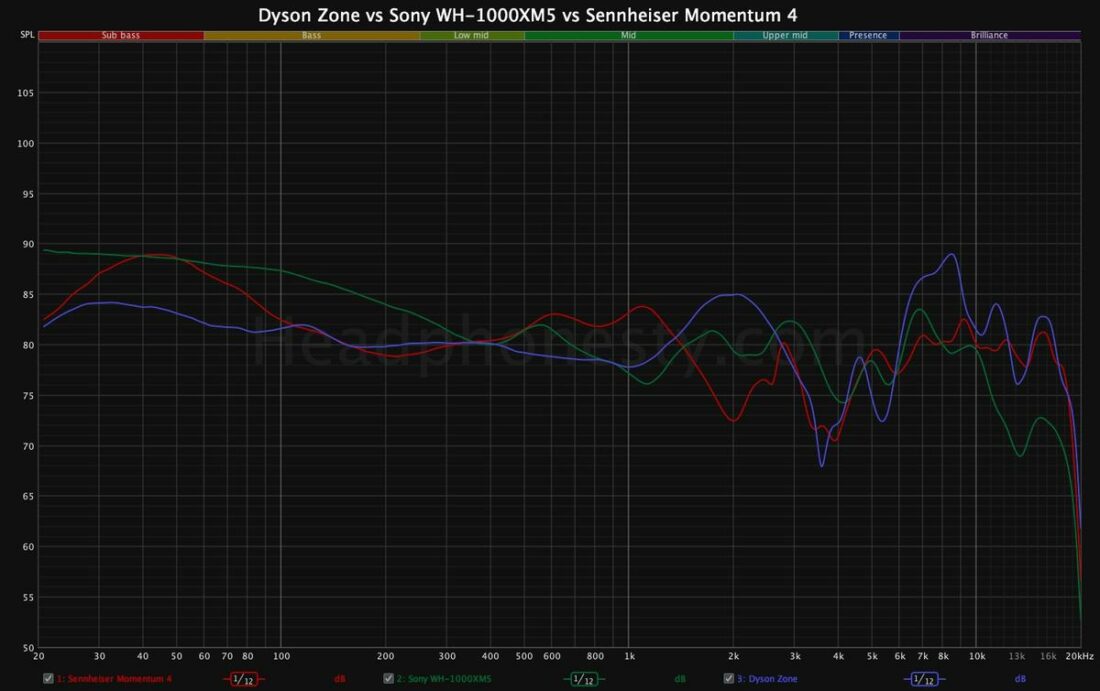
Active noise cancellation
One of my major complaints with ANC headphones is, well, the ANC. I just don’t like the feeling of pressure that heavy-handed noise cancellation can induce. I recently spent 50+ hours on airplanes and brought along the Sony WH-1000XM5, Sennheiser Momentum 4, and KZ H10 for the family.
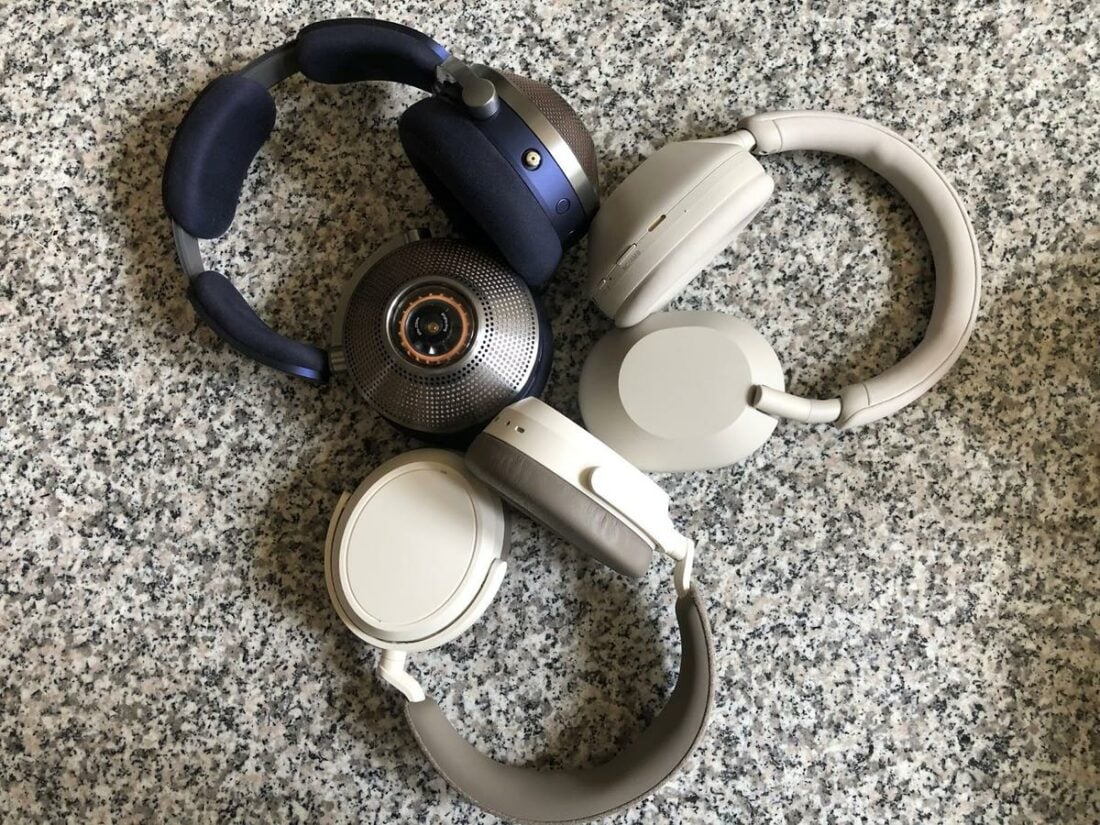
On the plane, they were all delightful. Want to sleep or hear your movie? Don the sweet, sweet, artificially created audio pseudo-silence.
But off the plane? Yuck. I just can’t stand the feeling of being in an acoustic submarine. I know I’m sensitive to it, and I’d likely get used to it if need be, but even on the lowest ANC settings, I far prefer good, old-fashioned, dumb headphones. I never listen to ANC headphones unless the circumstances require it.
Again, the Dyson Zone are a pleasant surprise. There’s only 1 level of ANC – you can’t adjust it. But, you know what? Dyson nailed it.
Going back and forth between the Sony and Sennheiser options, the Zone ANC is slightly less effective at blocking external noises (especially higher-frequency ones). However, the difference is that I can wear them all day long without feeling any pressure or discomfort.
The Zone sound merely quiet, not oppressive.
And unlike some other headphones, where ANC can not be disabled, the Zone allow for ANC to be turned off.
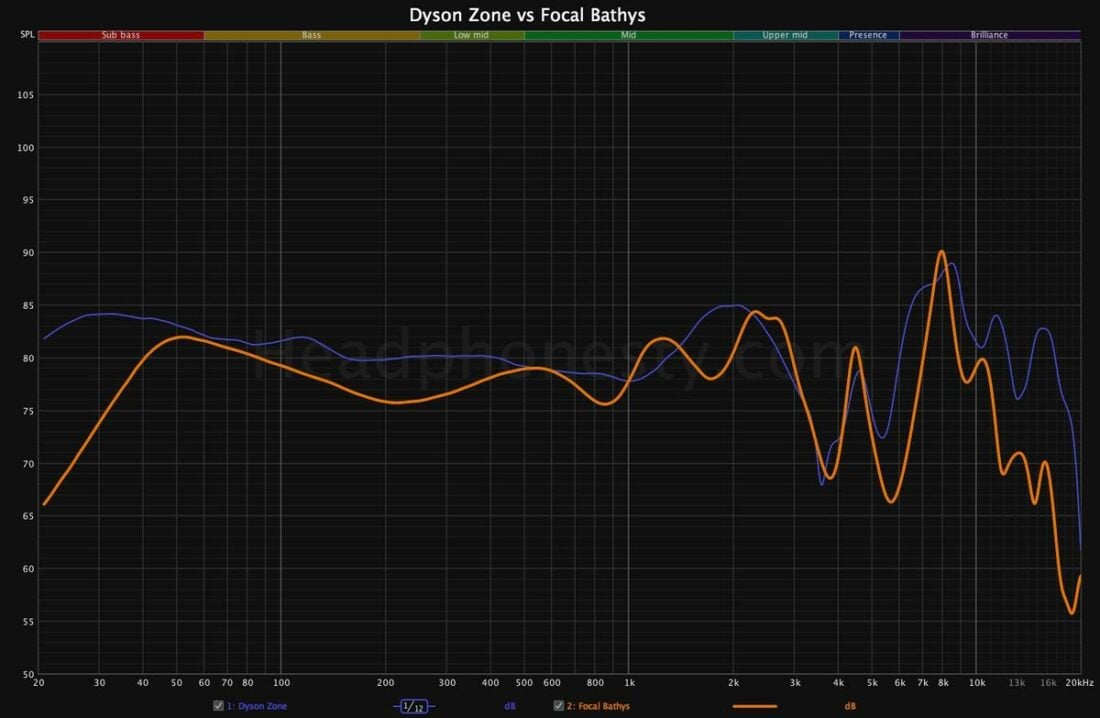
Connectivity ⓘ
- Audio Codec: SBC, AAC, LHDC
- Bluetooth Version: 5.0
- Auto-connect when: Put on head
- Average drop-outs in an hour: 0
- Multi-point connection: Yes
Bluetooth performance is rock stable, and I encountered no dropouts or connection weirdness. The range seems typical for a pair of BT headphones. The Zone uses Bluetooth 5.0 and the SBC, AAC, and LHDC codecs.
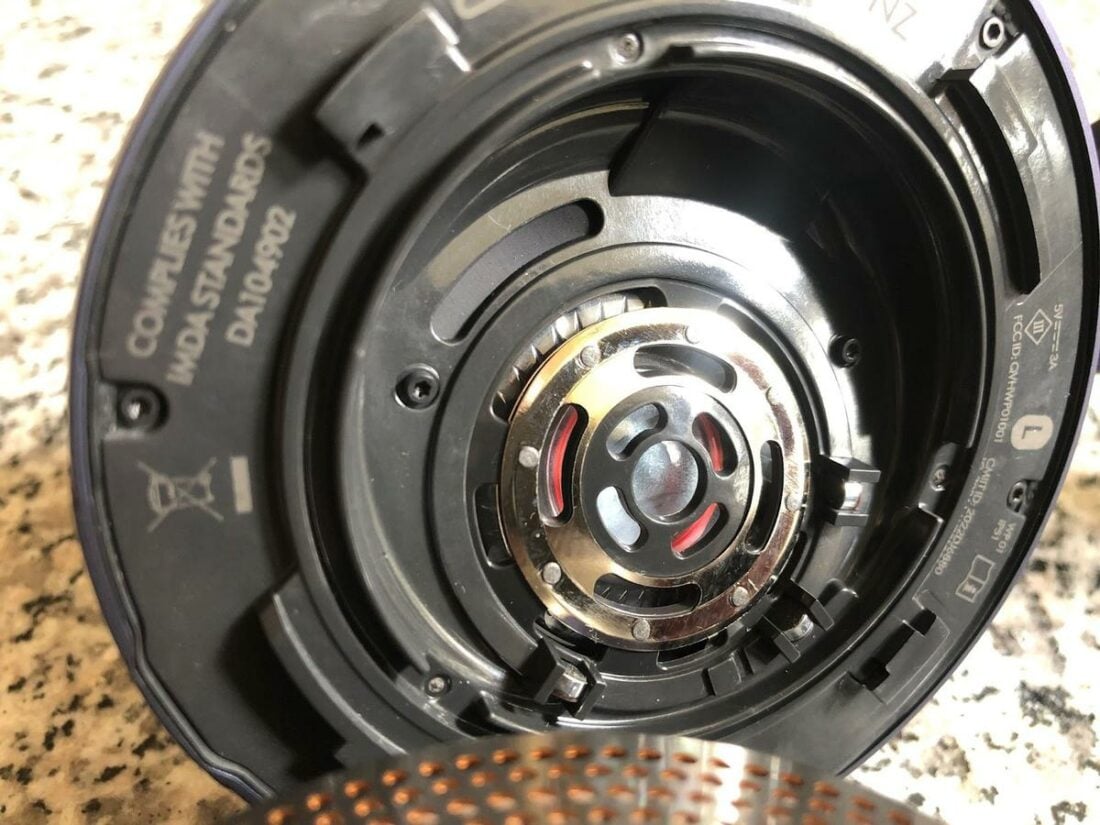
Waterproof ⓘ
- IP Rating: IP51, Good
Consider me surprised. I assumed that the open mesh cups with paper filters and fans would mean no waterproof rating. It turns out, I was wrong.
The Zone are rated IP51, which means protected from limited dust ingress and condensation. I’m still unlikely to go out in heavy rain with them, but I won’t panic if a little splash happens here and there.
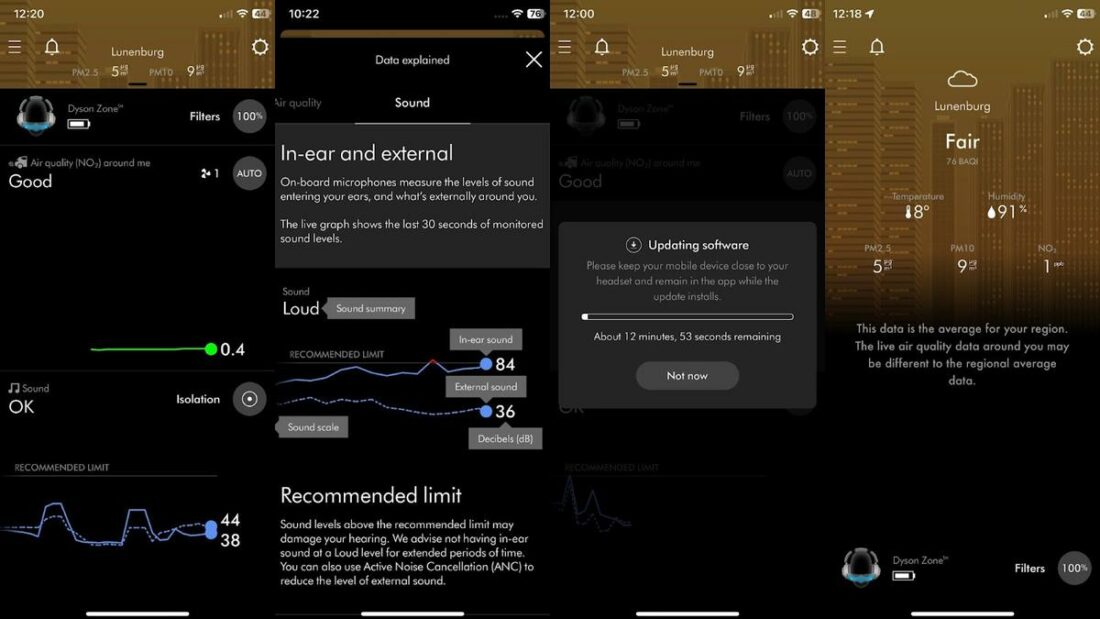
Software ⓘ
- Available on: Android, Apple
- Local weather and atmospheric conditions, battery level, filter life, NO2 air quality rating (live graph), fan controls, sound level in-ear and external (live graph), 3 preset EQ.
Already have a Dyson product and the associated app on your phone? Then there’s no need to download anything new for the Zone. The standard My Dyson app is all you need to control the Zone headphones.
Unsurprisingly, the My Dyson app offers unique features for a pair of headphones. The interface is split between air quality, fan, and sound options. The live graphs (of the last 30 seconds) for air quality and sound levels are an interesting and fun inclusion. Good explanations of the air quality and sound data are included with videos explaining usage.
The app’s sound settings are fairly rudimentary. ANC (on – Isolation, Off, Transparency) and EQ (Enhanced, Bass Boost, Neutral). But, as mentioned above, the implementation of these features is so good in the Zone, I’m not overly concerned by the lack of inclusion of a bunch of options I will never use.
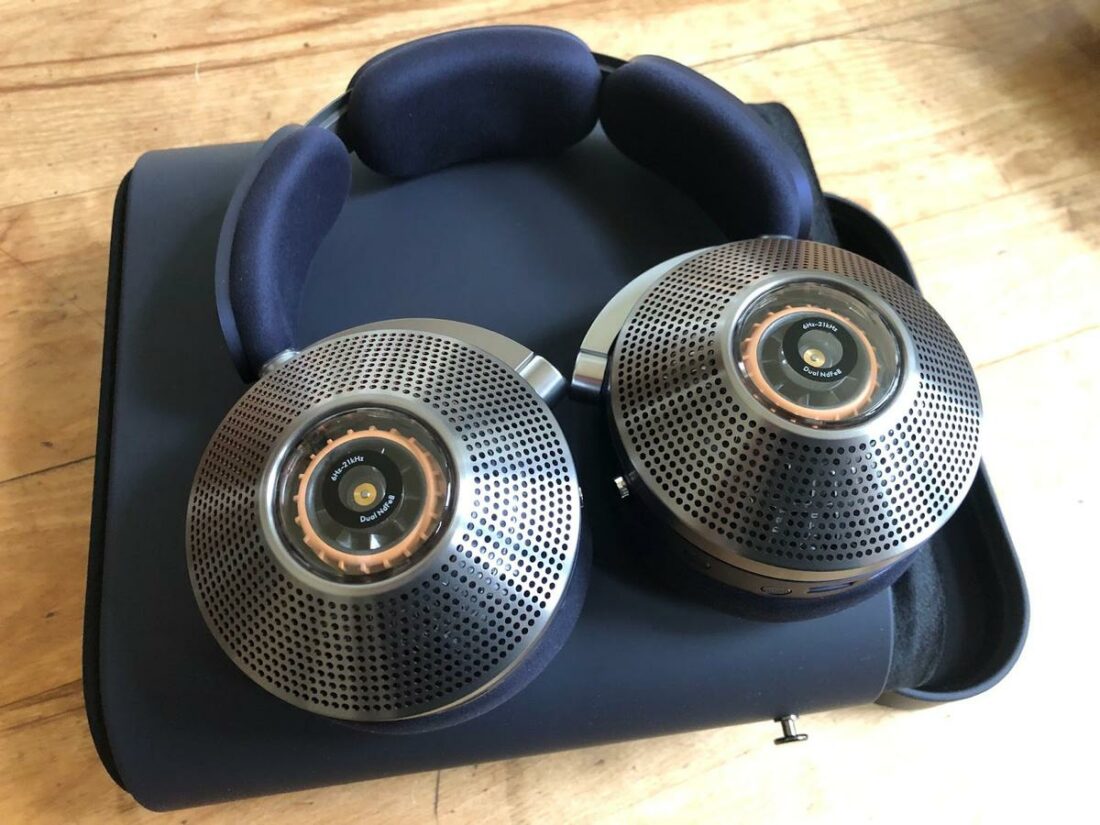
Conclusion
The Dyson Zone are low hanging fruit for the armchair critics. It’s easy to get caught up in their air filtration gimmick and superhero mask looks, forgetting that they are, in fact, a surprisingly good-sounding and terrifically well-made pair of ANC headphones.
If your frame of reference is limited to consumer ANC cans from the likes of Sony, Sennheiser, or Bose, the Zone will seem unwieldy. However, if you are familiar with larger audiophile headphones, the size, shape, and weight are nothing you haven’t encountered before.
Compromises, compromises.
Fans and filters add heft. Choosing metal over plastic for construction is the heavier but more robust and premium option. A less bass-boosted tuning isn’t the norm these days for consumer cans. Some will appreciate these choices, while others will be left scratching their head.
Priced around USD$1000, the Zone aren’t a viable option for most in the market for new commuting headphones. However, drop the fans, filters, and face mask, halve the price, and you’d be left with a fabulous pair of consumer ANC headphones that would seriously compete with the status quo.
But this is a vacuum company, after all, and blowing air around is kinda their thing.
Indeed, a non-mask version of the Zone would have received nowhere near the same level of attention (or should we say free marketing) for Dyson. This is a shame, as the accessories, construction, noise cancellation, and sound quality are superior to many alternatives and deserve recognition.
If I lived in a part of the world with frequent wildfires or excessive urban air pollution, perhaps the air-purification functionality would make the Zone worth the price of admission. For those commuters who suffer from seasonal allergies, they may be a godsend.
But they’re a very difficult purchase to justify for someone like me who only want them for audio, not air filtration. So no, the Zone certainly aren’t for everyone.
But they’re no joke either.
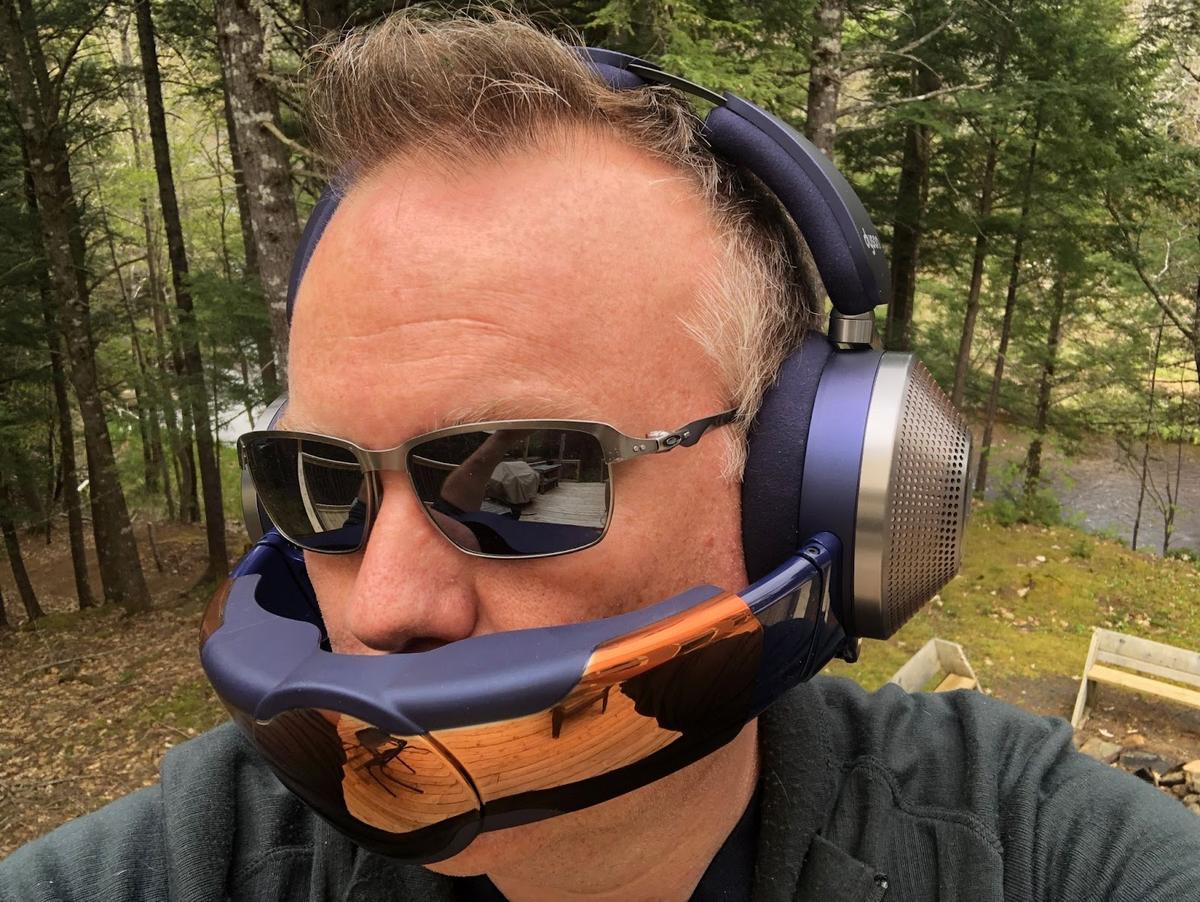
Can you test the headphones out with the aux cable? I have the regular versions and they didn’t come with the flight kit cables. I want to know if I can use them as simple wired headphones? in your experience, would I be wasting my time, or would listening to these wired give me a different experience? Thanks
-R
Hi. Using the cable bypasses the Bluetooth and the audio controls do not function. You can use them this way, but I wouldn’t bother (unless you have no other choice) as the Bluetooth and app functionality is a major part of all wireless ANC headphones. You won’t gain sound quality or any other benefit.
Dyson, the brand that is known for sucking enters the headphone market by providing the listener with its own fans and filters.